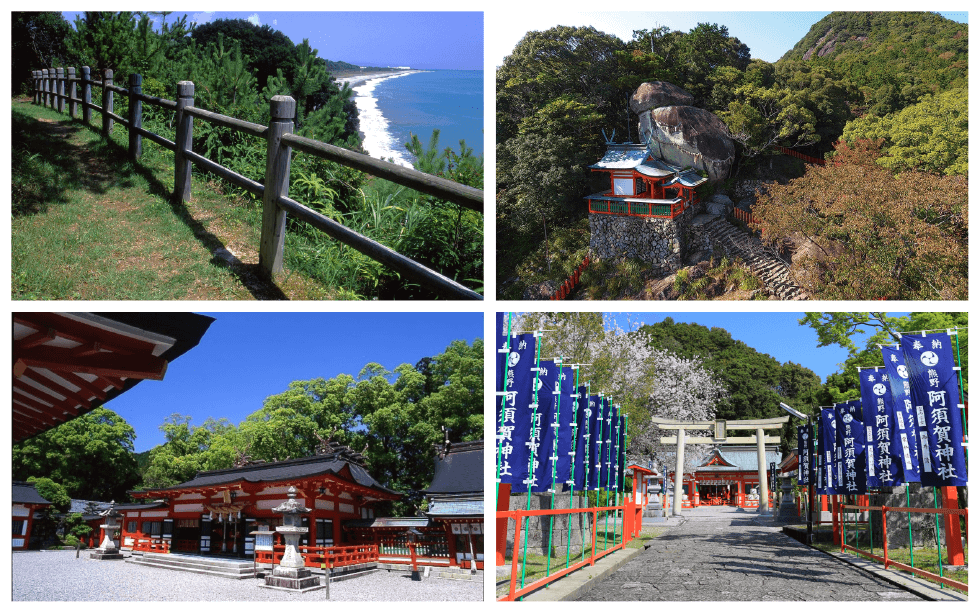
Designated as a UNESCO World Heritage site, the Kumano Kodo is located in Shingu City, Wakayama and is a popular sightseeing destination for both Japanese and foreign travelers as a spiritual sacred site. In the Shingu area, you can enjoy walking the ancient pilgrimage routes themselves, and visiting a number of different shrines or “power spots”. The Kumano Kodo spreads out in all directions from Shingu area, connecting the Grand Shrine at Nachi, one of the three Kumano Sanzan shrines, and the Nachi Waterfall, one of the best-known waterfalls in Japan. The route will take you out further to Yoshino-Kumano National Park, part of which was designated as a UNESCO World Cultural Heritage site called the Sacred Sites and Pilgrimage Routes in the Kii Mountain Range. Within the park, you can truly appreciate and connect with the beautiful nature of the Kii Peninsula.
Here, my 30-year-old travel writer self will introduce how to walk and enjoy the Kumano Kodo along with some historical background on the way.
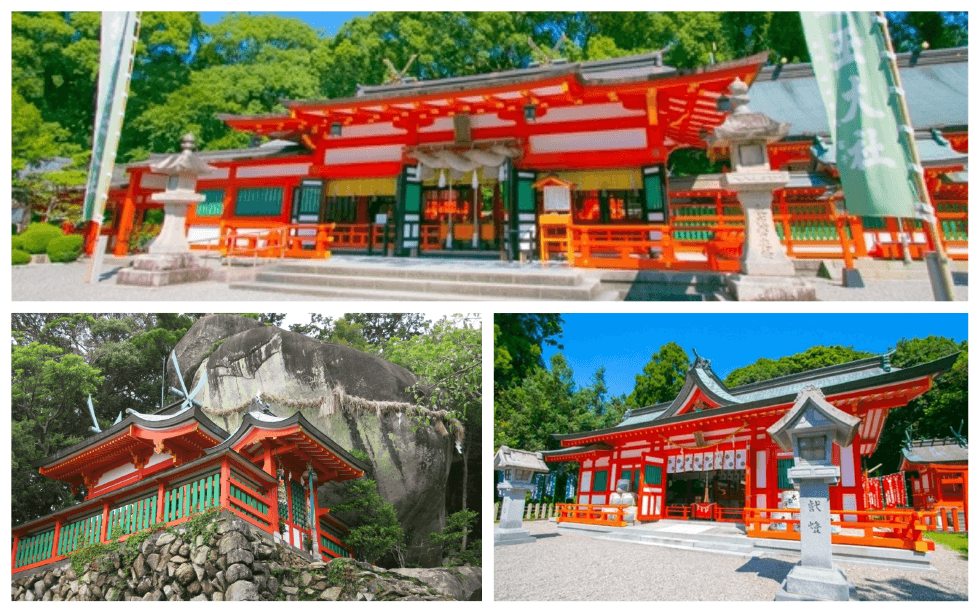
When you arrive in Shingu City, the first thing you will want to do is visit the three UNESCO World Heritage sites in the city: Kumano Hayatama Taisha Grand Shrine, Asuka-Jinja Shrine, and Kamikura-Jinja Shrine.
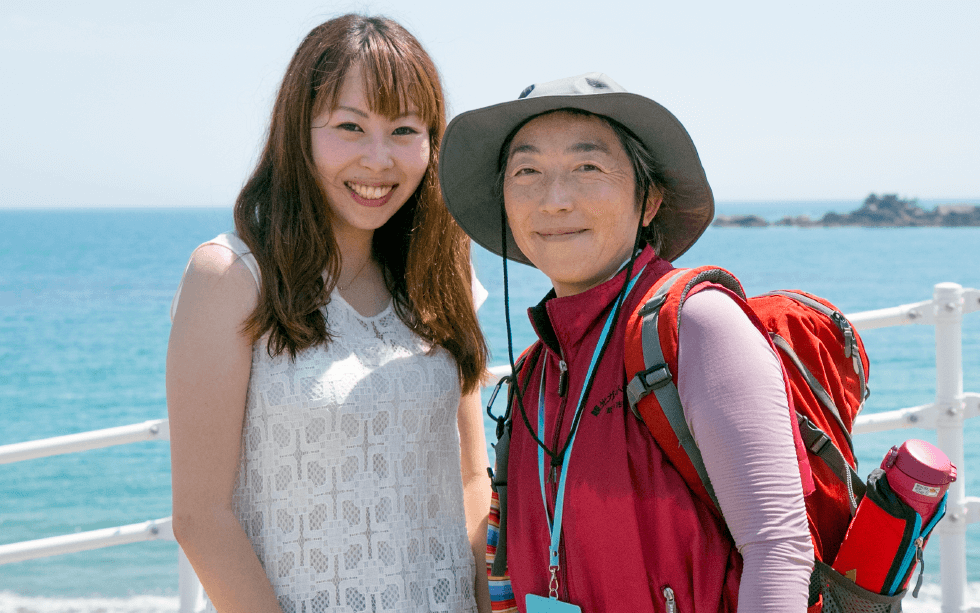
On this trip, I was accompanied by Ms. Hitomi Tamaki from the Shingu City Tour Guide Group.
With my local tour guide in tow, my visit to the three shrines can finally begin.
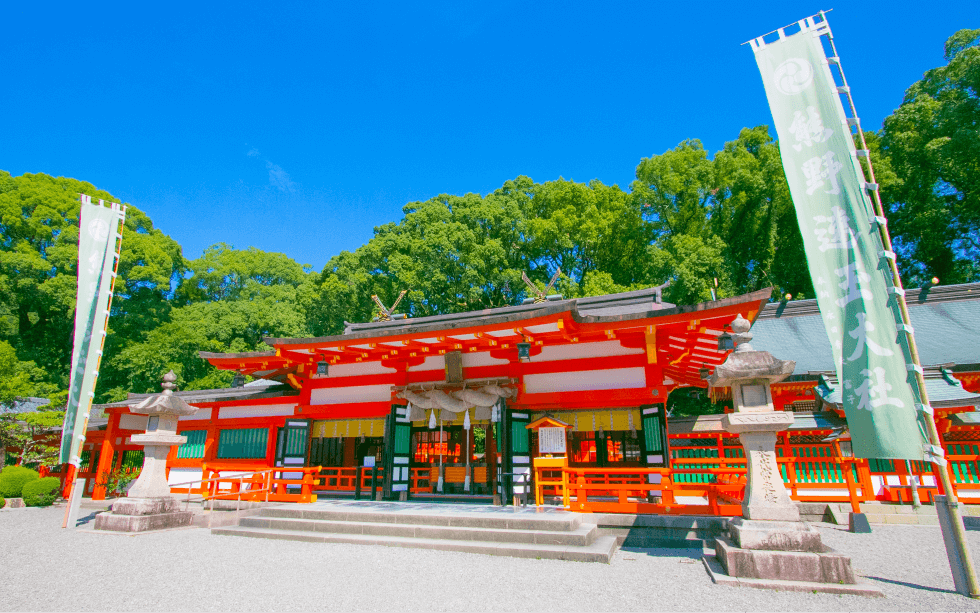
First, we visited Kumano Hayatama Taisha Grand Shrine, which is also a registered World Heritage site under the Sacred Sites and Pilgrimage Routes in the Kii Mountain Range. It is one of the Kumano Sanzan shrines and one of the head shrines of over 3,000 Kumano shrines in the country.
While the first shrine from which the gods of Kumano descended is Kamikura-Jinja Shrine, of which I will talk about later, regular people were not allowed to enter the mountain except during religious festivals. Therefore, Kumano Hayatama Taisha Grand Shrine was built for people to visit and worship the gods during ordinary times. The shrine has many visitors, including the Imperial Family.
Purifying your hands at the chouzuya (purification pavilion) and then standing in front of the shrine, I realized just how in awe the sight of the shrine left me. Enshrined here are Kumano Hayatama-no Okami and Kumano Fusumi-no Okami, the two gods who became the first couple in Japan, who are often compared to Izanagi-no Kami and Izanami-no Kami from classical Japanese literature like The Chronicles of Japan. As such, the shrine is said to bestow benefits of "marriage" and "family safety" to its visitors.
When I was paying my respects, I was able to hear an interesting story about the shrine from a Shinto priest. He told me that the vermillion color of the shrine is influenced by Chinese Buddhist culture and wards away evil spirits. He also told me that the structure of the shrine was built using the Gongen-zukuri style. If you look upwards at the shrine you'll notice that the Chigi, the timber placed on the roof, has a “heart-shaped” pattern. At first I thought it was like this because this shrine was known for its benefits to marriage, but he told me that the pattern is actually called “Inume” and has been used in Japanese sculpture since the Heian period.
Last but not least, I visited the Sacred Nagi Tree. Leaves of this some 1,000 years old tree have been cherished as an amulet for fishermen, because the word “nagi” in Japanese also means “calm wind”. Furthermore, it's said that the leaves were used as an amulet for a safe journey when people travelled the Kumano Kodo for pilgrimages.
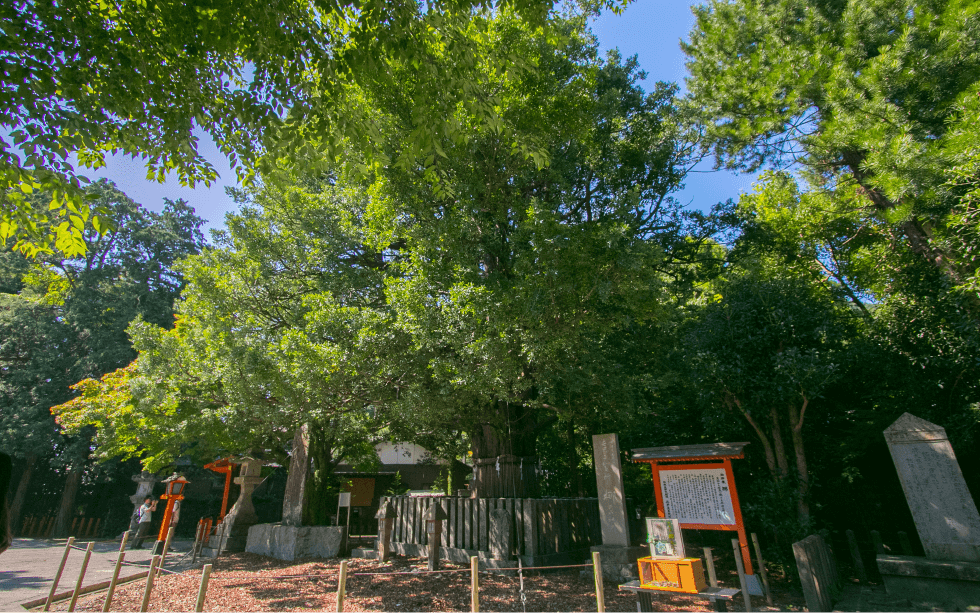
This is the Sacred Nagi Tree. We are not allowed to touch it as it's designated as a natural monument of the country.
At the shrine’s management office, you can buy a "Nagi-mamori", an amulet in the shape of the Nagi leaf. They told me that it is meant to attract long-lasting and deeper relationships with others, as well as an unbroken stream of wealth because the Nagi leaf itself is hard to tear apart.
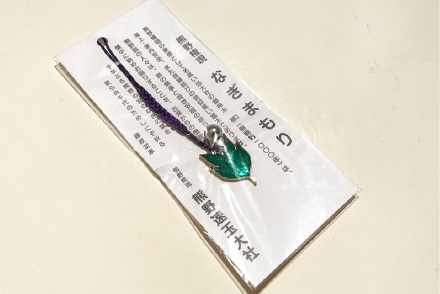
I definitely wanted the amulet after hearing that story.
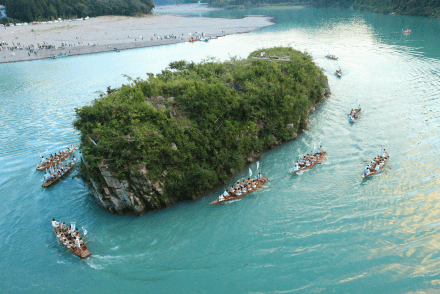
Kumano Hayatama Taisha Grand Shrine also holds an annual festival called Mifune Matsuri.
Mifune Matsuri is a Shinto ceremony that has lasted for some 1100 years. At the ceremony, nine rowboats including the vermillion-colored shinkou bune (onto which the divine spirit is loaded), morota bune, and saishu bune make three laps around Mifune-jima Island. It is held on October 16th every year.
<DATA>
・Kumano Hayatama Taisha Grand Shrine
Address: 1 Shingu, Shingu-shi, Wakayama
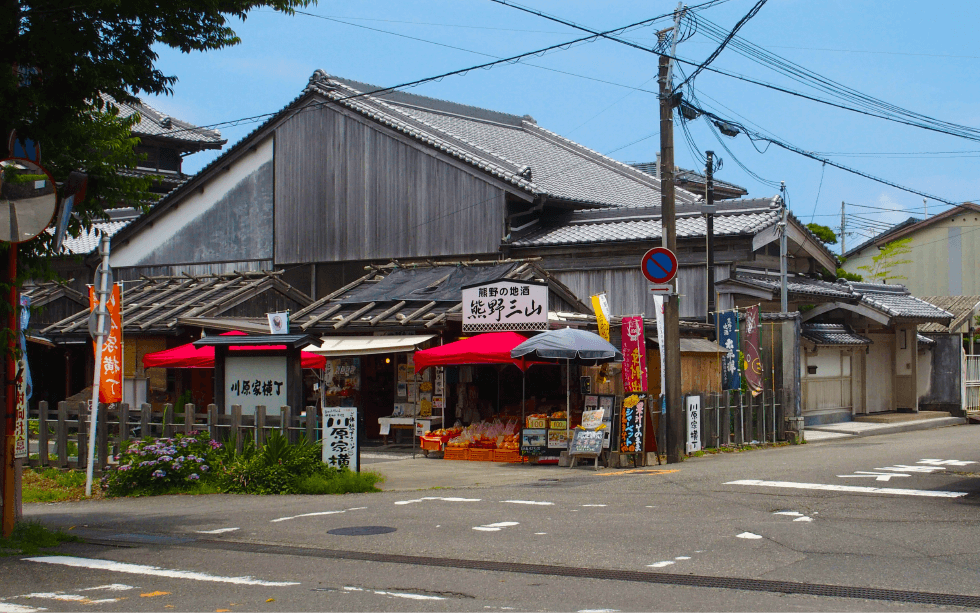
After visiting Kumano Hayatama Taisha Grand Shrine, we stopped at the Kawaraya Yokocho for a break. Kawaraya Yokocho is a sightseeing spot created to reproduce kawaraya, or simple riverside stores used from the Edo period to the Taisho period, so that people can relive the historic atmosphere from the temple towns of the past.
Every weekend and on national holidays, you can see a pictorial guide of the Kumano-Shingu Pilgrimage Mandala. The pictorial guide refers to storytelling using a large painting. It is said that Buddhist nuns called Bikuni travelled throughout the country carrying the picture to attract worshippers to the Kumano area, and the money charged to listen to the bikuni's explanation helped to pay for shrine repairs. Both the Shingu Pilgrimage and Kumano Hongu Pilgrimage Mandalas did not exist until the Kumano Pilgrimage Routes were registered as a World Heritage site.
I was able to listen and learn about a variety of stories from the pictorial, including about Emperor Jinmu going up Mt. Kamikura under the guidance of a mythical raven, the scholar Jofuku visiting Japan, and a story that the Tales of Ugetsu is based on.
If you wish to listen to this pictorial guide on weekdays, the paid on-site service is also available. With this on-site service, you can choose which story you would like to hear and also listen to the stories in English.
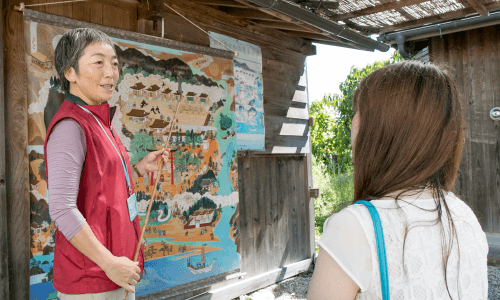
A special pictorial guide by Ms. Tamaki. I was captivated by her storytelling.
<DATA>
・Kawaraya Yokocho
Address: 1-2-1 Funamachi, Shingu-shi, Wakayama
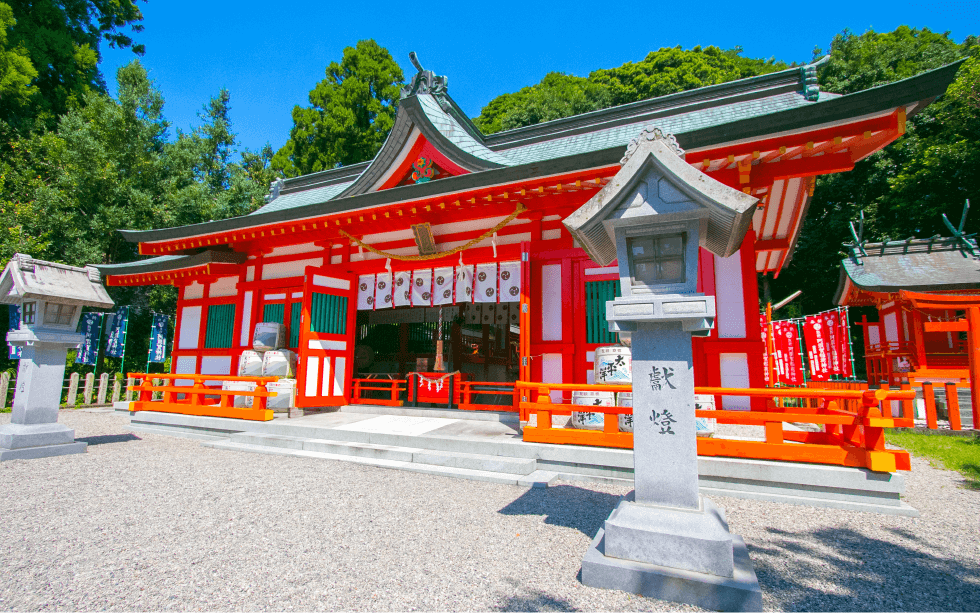
Next we visited Asuka-Jinja Shrine. Going through the simple stone torii gate almost feels as if you are being embraced by the shrine's history and dignity, the beautiful contrast of the painted vermillion and white stone is truly a visceral visual experience.
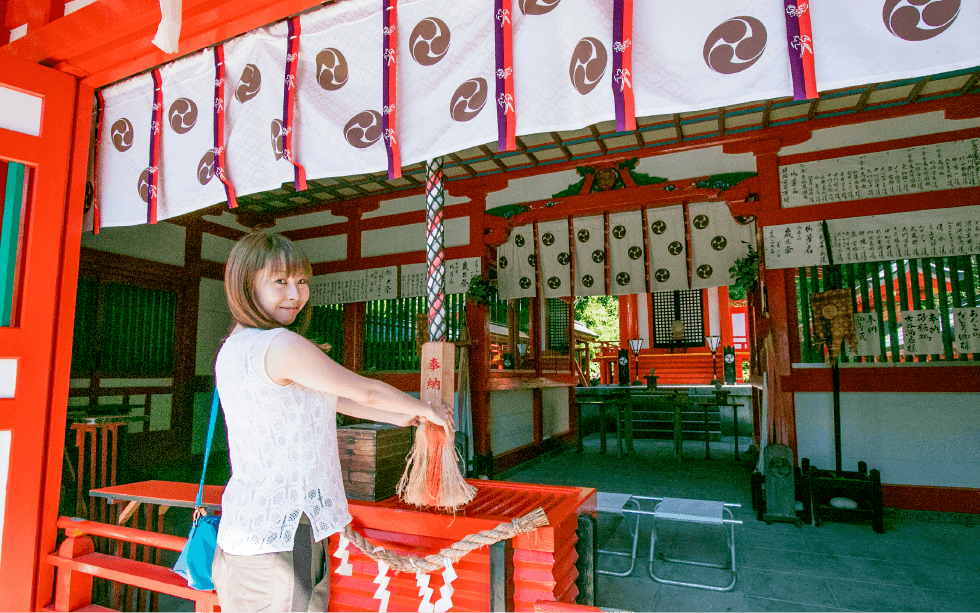
Remember to pray for a safe trip!
Asuka-Jinja Shrine was made originally to enshrine the “god of the land", a god that protects us from the storm surges of the sea. As it is also a shrine-temple, that is a shrine that enshrines an ancient Shinto deity and practices Buddhism, Daitokumyoo (a Buddhist deity) is also enshrined here.
On the right side of the main hall, there is a small altar called the "Jofuku Palace". They told me it's because the sacred body of the god enshrined in Asuka-Jinja Shrine is Mt. Hourai, which sits behind the main hall of the shrine. Xu Fu is said to have arrived in Japan to find the elixar of life at the order of the Emperor of Qin.
At Asuka-Jinja Shrine, I was able to listen to a yokobue performance on a type of Japanese flute by Mr. Nishi. The beautiful tone of the flute made it feel as if spiritual power of the shrine was being coaxed out from the very seams of the hall itself. Finally, I received a blessing from him saying “there seems to be good things for you today".
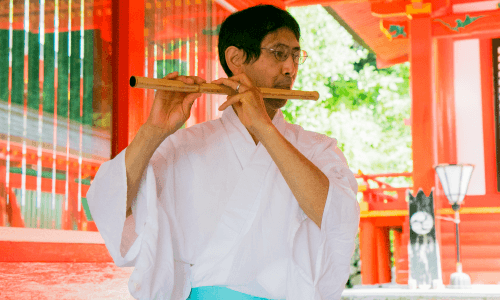
The sound of the flute played by Mr. Nishi, Shinto Priest of Asuka-Jinja Shrine.
<DATA>
・Asuka-Jinja Shrine
Address: 1-25-25 Asuka, Shingu-shi, Wakayama
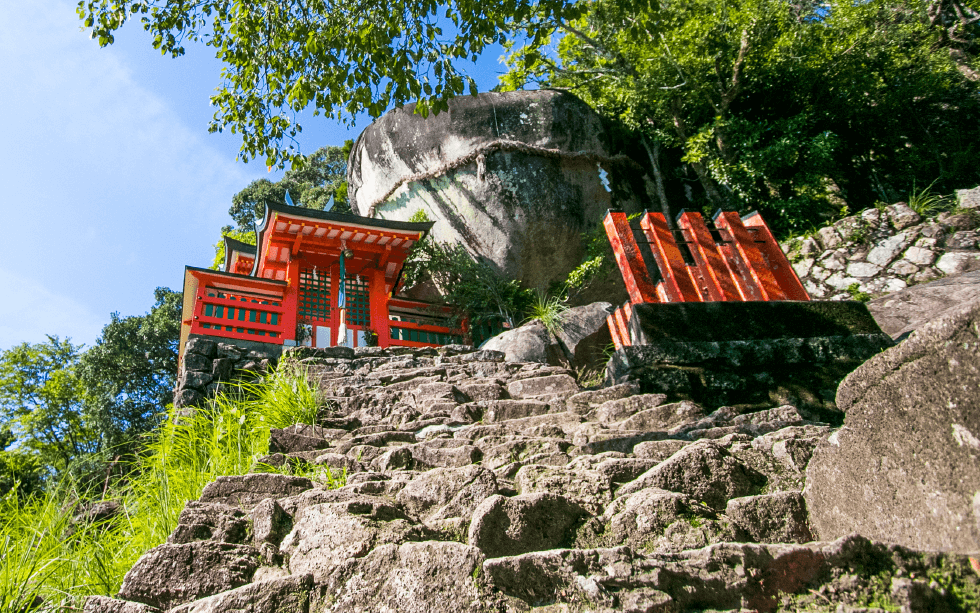
The last shrine we visited is Kamikura-Jinja Shrine, which is said to be the birthplace of Kumano worship. Since Kamikura-Jinja Shrine is at the top of Mt. Kamikura, we had to go up the stone steps that are believed to have been donated by Minamoto-no Yoritomo, the first shogun of the Kamakura period. I was told in advance from the guide that the stone steps were nothing like an ordinary staircase, but when I actually saw the steps in person, I almost froze on the spot.
But at the top of the mountain there is the “Gotobiki-iwa rock”, the biggest power spot. This rock is also the goshintai (sacred body) of Kamikura-Jinja Shrine, and it's believed that you can gain power by just touching it. Plus, that is the place where the god of Kumano first descended. Well, there's nowhere to go but up from here!
While going up the 538 stone steps, my guide told me about the “Oto- Matsuri Festival”, a festival held at the shrine. This festival of fire is held on February 6 every year. Only men can participate and enter the mountain, though men of any nationality can participate.
On the day of the festival, the men who will climb the mountain undergo a process called "Shoujin Kessai", a tradition where they purify their bodies through abstinance, though the Oto Matsuri Festival in Shingu has the added caveat of only eating white foods on top of this. After climbing to the shrine, they receive the sacred flame on their torches, and return downwards to home. The purpose of the festival is to receive the sacred fire to bring in the New Year. When the men return home, they light up the kamidana (miniature household Shinto alters) and Buddhist alters at home with the flame and cook rice. I was a little disappointed because I am not allowed to participate in the festival, but the guide told me that the role of women in this festival was to use the flame and provide food afterwards, which is just as important as the role given to men.
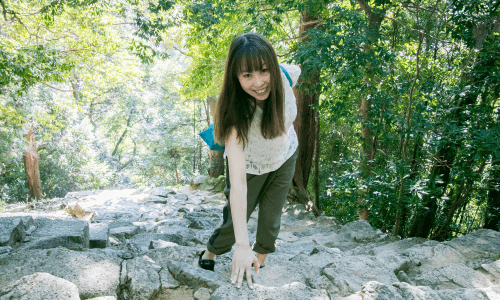
Because it was so steep, I took my time to go up safely, holding each of the steps by hand.
On the day of the festival, the sight of the flames descending down the mountain is breathtaking, looking almost like a river of fire, and the embers that fly off the wooden torches shoot out like flying butterflies set aflame. In Shingu, there is a saying: "The mountain becomes a waterfall of fire, and a dragon comes down to us”. The scene of a roaring fire lighting up the darkness coming down the mountain like a cascading dragon with the cheers of the men reminds us of this saying. She also told me that the men at the festival are very cool! I would love to see them one day!
The stone stairs that were painful at the start gradually shifted to an easier pace as we arrived at the summit safely. The Shinto god enshrined here is Takakuraji-no Mikoto and Amaterasu Omikami.
However, the thing with the biggest impact here is Gotobiki-iwa rock, which is the largest power spot. While the rock is the sacred body of a god, you are allowed to touch it. Since most sacred bodies of Shinto gods are never this accessible to the general public, this is quite the rare experience. As soon as we arrived at the top, I visited the shrine and touched Gotobiki-iwa rock on its bottom side, as if I was pushing it upwards, to absorb its spiritual power! Though I was exhausted from going up all the stone steps, I felt like I got back some energy!
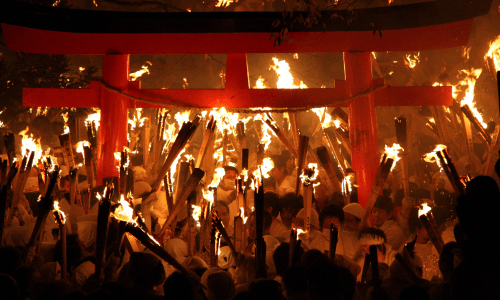
They showed us a picture of “Oto- Matsuri Festival”, where only men can participate. *This is a Nationally-designated Important Intangible Folk Cultural Asset
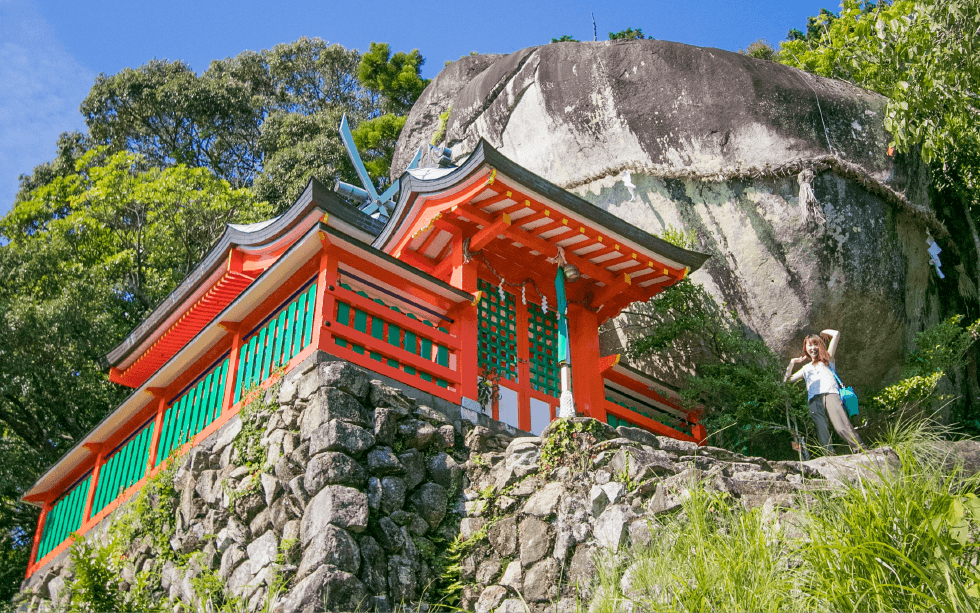
I know it’s a cliché pose, but I just had to push it up!
<DATA>
・Kamikura-Jinja Shrine
Address: 1-13-8 Kamikura, Shingu-shi, Wakayama
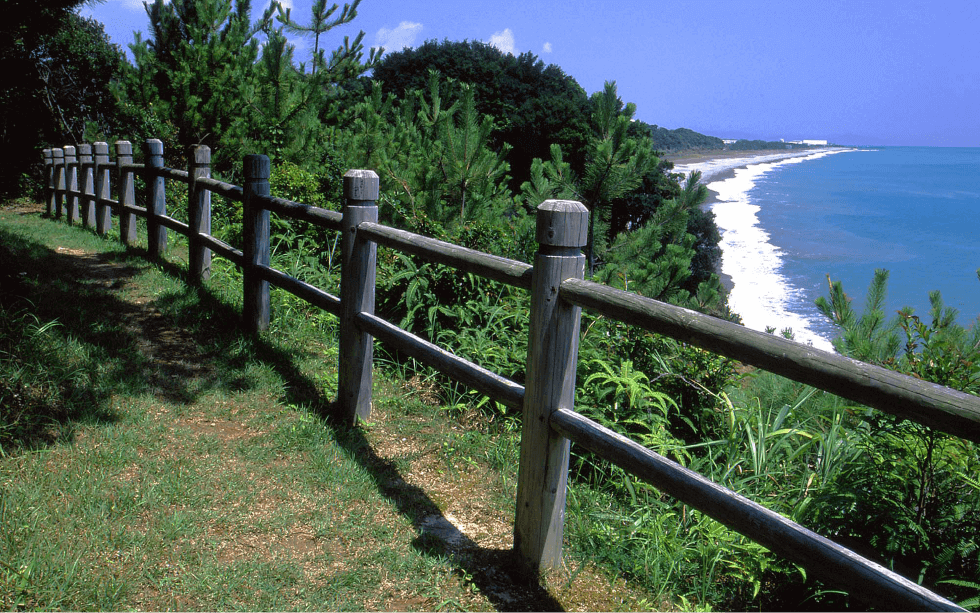
After getting some spiritual power, you might want to explore the Kumano Kodo. But the Kumano Kodo is composed of several routes including Nakaheji, Koheji, Oheji, and Kiiji, though even the courses for beginners sounded too hard for my out-of-shape body.
Thankfully, my guide enlightened me with her words: “Any way that takes you from home to Kumano is Kumano Kodo.” Of course, the routes that are registered as World Heritage sites meet several criteria like being listed on official documents and having the paths maintained properly to this day. But what she really means is that the Kumano Kodo is also a route you make for yourself.
So, I asked her to guide me through a round-trip course from Koyazaka slope to the scenery point of Ojigahama coast. This route takes about an hour and is suitable for beginners.
I recommend you rent a car or take a taxi to get to the Koyazaka slope starting point, as you want to save time and your energy to enjoy the Shingu area efficiently!
When you arrive at the starting point of Koyazaka slope, make sure you use a restroom before you start walking. Don’t forget to take water bottles with you to stay hydrated!
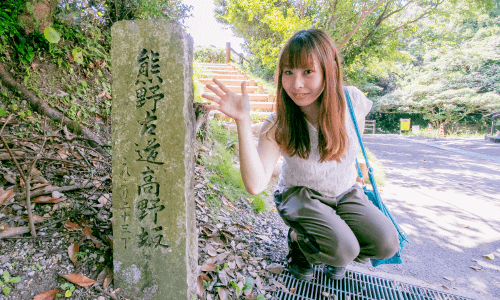
This time, we started from the Koyazaka slope starting point (wide angle side).
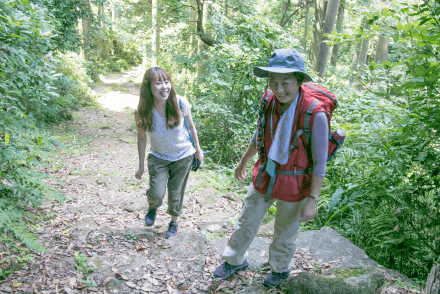
Time really flies while walking the Kumano Kodo and listening to such interesting stories from the guide.
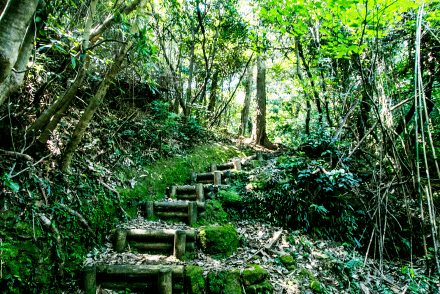
The course itself is not that steep, but we proceeded with caution.
Finally, we made it to the scenic point that watches out Ojigahama coast, the finish point of this journey! The contrast created by the shining blue sky, the gleaming emerald ocean, and the trees swaying slowly under the sunshine is the most superb view and a great way to end the walk! The course was very satisfying as I was able to enjoy the Kumano Kodo and this superb view in around an hour.
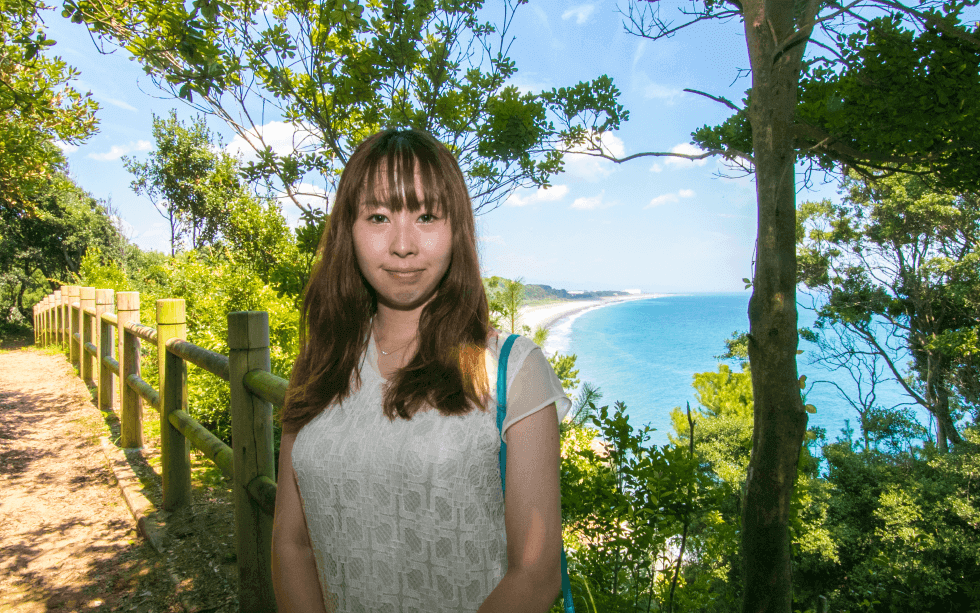
Taking a picture with the superb view of Ojigahama coast. It always brings back memories of our journey!
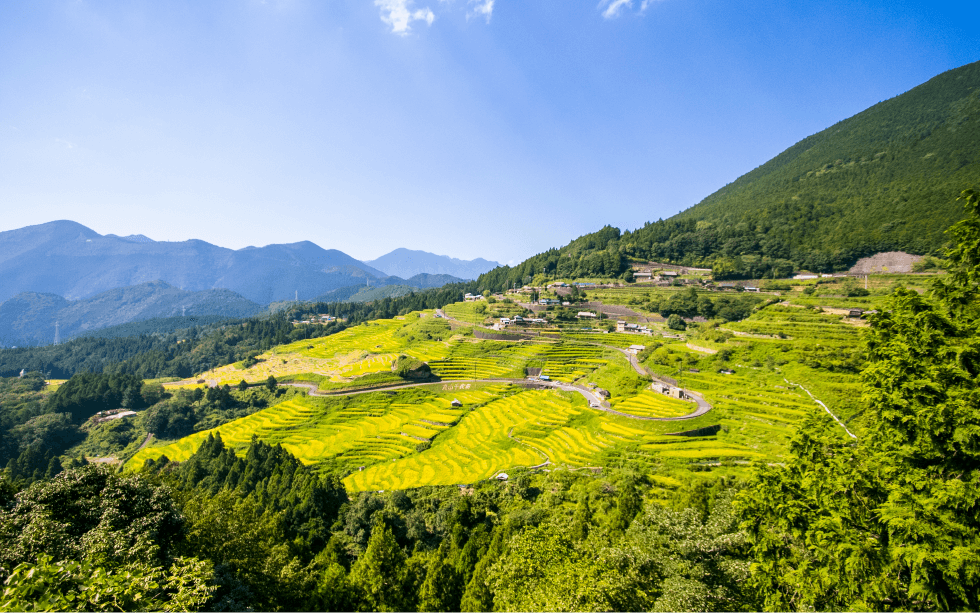
After saying good-bye to the guide, I wanted to see some more photogenic scenery. So I decided to rent a car and drive a little ways away to Maruyama Senmaida.
Maruyama Senmaida is a terraced rice field on the slope of the Maruyama district of Kiwa Town. The spectacular view of the terraced rice field which folds over and over is wonderful, so much so that it has been chosen as one of the 100 rice terraces in Japan.
If you drive for an hour by car from the Shingu area, you'll arrive at your destination. Because the mountain road becomes narrow as you get closer to Maruyama Sendaima, please make sure to drive carefully while letting oncoming cars pass when necessary. Looking down Maruyama Senmaida from the observation spot, the lush green scenery will make you feel like it was worth the drive. I could not stop taking pictures from the observation point, but I'm not sure they could do it justice anyway.
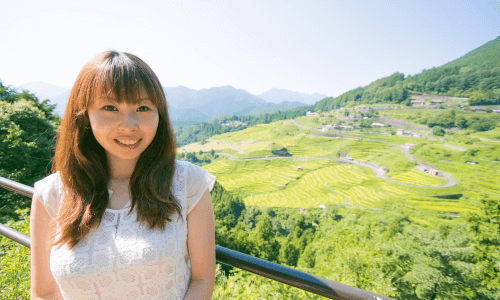
If the Ojigahama Coast provides a spectacular view of the ocean, Maruyama Senmaida is its magnificent mountain counterpart! They are both wonderful.
<DATA>
・Maruyama Senmaida
Address: Maruyama, Kiwa-cho, Kumano-shi, Mie
After walking the course, I am certain that you will definitely enjoy your walk with an experienced guide who knows where to go and how to enjoy everything in the area, rather than walking by yourself. There is a guide fee to pay, but your satisfaction will be much higher so it is well worth it!
A guide group called the "Wakayama Local Guide Association" has been formed by volunteers in the Kinan area. The group also provides guide services in multiple languages including English.
The guide navigator for this trip was
Hitomi Tamaki, from the Shingu City Tour Guide Group.
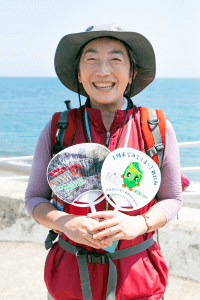
<DATA>
・Shingu City Tourist Association
Address: 2-1-11 Jofuku, Shingu-shi, Wakayama
Phone: 0735-22-2840
Guide Fees (Shingu City Tour Guide Group): Kumano Hayatama Taisha Grand Shrine: 2,000 yen / Asuka-Jinja Shrine: 2,000 yen / Kamikura-Jinja Shrine (up to Gotobiki-iwa Rock): 3,000 yen / Koyazaka slope: 4,000 yen / Pictorial Guide: 5,000 yen (Up to 2 pieces), 8,000 yen (Up to 4 pieces)
*Guide fees will be the same for up to 20 people (All rates refer to guide services in Japanese)
・Wakayama Local Guide Association
Phone: 0739-33-7451
*Services available in English